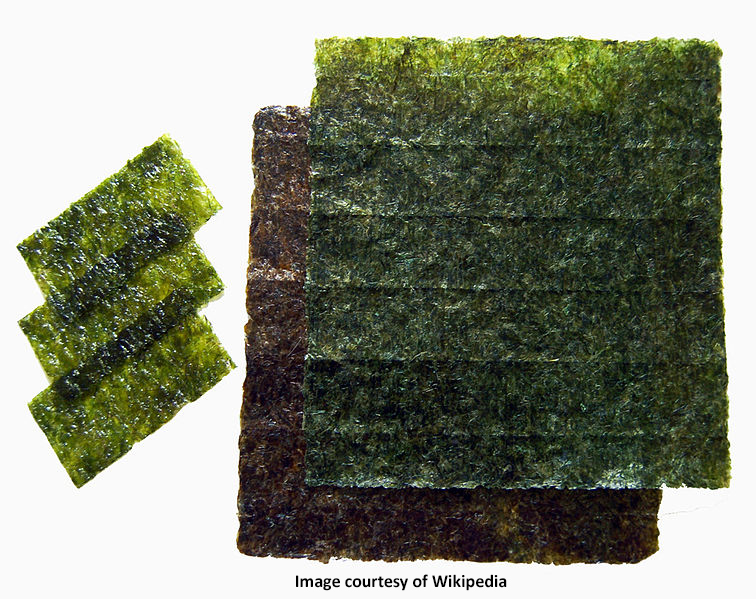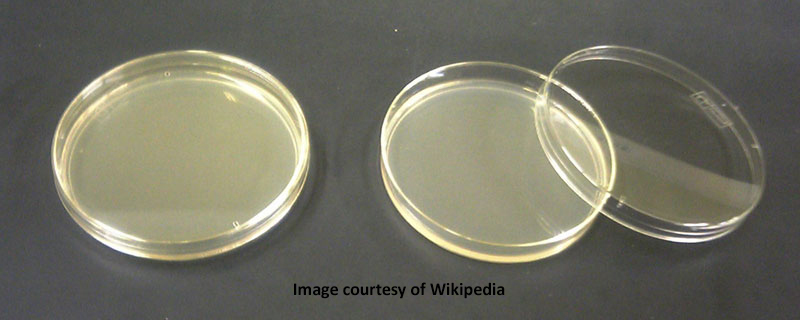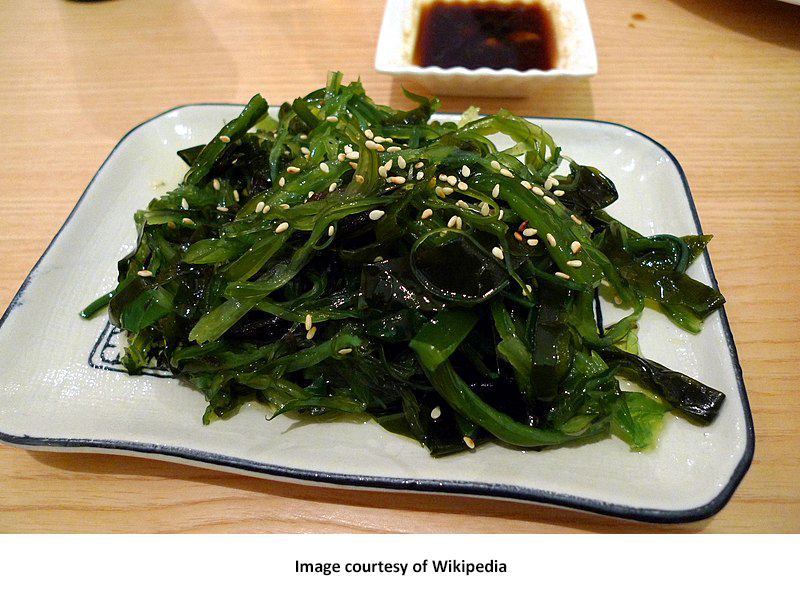Traditional Uses
Seaweeds are diverse, coming in a wide variety of shapes and sizes. They are found in almost all the Earth’s oceans. The three major types are brown, red, and green. Most brown and red seaweeds are edible and found in salt water. Green seaweeds, on the other hand, are primarily freshwater and not consumed as food. The most popular seaweeds used as human food worldwide are
- Nori – which despite its color in stores, comes from a red algae
- Kombu – an edible kelp
- Wakame – another edible kelp and one of the world’s most “invasive” species
 Seaweed is a traditional food in Asian nations such as China, Japan, and Korea. In Japan, the average adult intake is around 14 grams (0.5 ounces) per day. It is also consumed in geographically and culturally diverse countries such as Mexico, France, and Austria. These ‘sea vegetables’ are commonly eaten in sushi, salads, and dried snacks.
Seaweed is a traditional food in Asian nations such as China, Japan, and Korea. In Japan, the average adult intake is around 14 grams (0.5 ounces) per day. It is also consumed in geographically and culturally diverse countries such as Mexico, France, and Austria. These ‘sea vegetables’ are commonly eaten in sushi, salads, and dried snacks.
In Germany, seaweeds are used to produce algenbrot, a bread consisting of a blend of cereals and up to 3% seaweed. In Brittany, the western peninsula of France, minced seaweed in butter is used for cooking and spreads. The taste for seaweed in the US is growing and becoming normalized due to immigrants arriving from Asia and Mexico. Presently the US uses seaweed and its components in foods, fertilizers, animal and fish feed, biofuels, pharmaceuticals, and cosmetics.
What Do Hydrocolloids Do?
First, a word about hydrocolloids: these are long chains of sugars and proteins. They are polymers whose hydroxyl group, the -OH, makes them soluble in water. They create dispersions - a mixture of a solid and a liquid that lies somewhere between the solid being completely dissolved or being suspended in the liquid. As functional food additives, they can influence a liquid's thickness (viscosity) and texture. Hydrocolloids improve our sensory experience of foods.
Agar, alginate, and carrageenan are hydrocolloids made from seaweed. They are highly valued and used widely for their gelling, thickening, and stabilization properties. Many seaweed components contain antioxidants, which can replace synthetic antioxidants to provide a clean label.
 If you’ve ever worked in a microbiology lab, you know agar. Agar plates are used to grow, and culture bacteria in the lab - Its value in research and food safety cannot be overestimated. For vegans and vegetarians, agar is vegetable gelatin as it uses no animal products. It forms a rigid gel at room temperature and is used in producing jellies, fruit candies, and canned meats, to name just a few food applications. It doesn’t require using potassium or calcium salts to thicken, a desirable quality that helps avoid adding salts in foods such as cheeses.
If you’ve ever worked in a microbiology lab, you know agar. Agar plates are used to grow, and culture bacteria in the lab - Its value in research and food safety cannot be overestimated. For vegans and vegetarians, agar is vegetable gelatin as it uses no animal products. It forms a rigid gel at room temperature and is used in producing jellies, fruit candies, and canned meats, to name just a few food applications. It doesn’t require using potassium or calcium salts to thicken, a desirable quality that helps avoid adding salts in foods such as cheeses.
Alginate is used in desserts, ice cream, fruit juices, bakery items, and milkshakes as a thickening agent and stabilizer. The ability to provide a smoother, creamier texture can serve as a fat replacement to lower the caloric content of a product. Fruit and vegetable processors coat their produce with edible alginate to protect the appearance, increase the shelf-life of their fresh products and reduce microbial contamination.
Carrageenan binds water to form gels. In dairy products such as cheese, chocolate milk, and cocoa, it binds the milk proteins and keeps them in suspension. Carrageenan enables crystallization in ice cream and helps keep it frozen during transportation from the processing plant to the grocery store. Like alginate, it can be used to produce healthier processed foods by replacing fat.
Besides functional properties, seaweeds are being used to fortify the nutritional composition of foods, especially bakery and vegetable-based products. Wakame has been used to improve the nutritional profile of pasta.
Nutritional Benefits
Seaweed is a good source of dietary protein, essential amino acids, calcium, iodine, magnesium, and vitamins A, B, C, and E. More importantly, seaweeds are a good plant source of vitamin B12, a vitamin found only in animal products or fortified foods. Seaweeds, by reducing the risk of a vitamin B12 deficiency in a vegetarian or vegan diet, help prevent anemia, weakness, vision loss, and possibly depression. Seaweeds have a higher proportion of essential fatty acids than land plants, including omega-3 and soluble dietary fiber (55-70%). Soluble fiber is known to have a prebiotic effect in the gut while reducing the glycemic response and plasma cholesterol.
Because they grow in a marine environment, seaweeds have rich and diverse sources of minerals. They are an excellent source of iodine and can be used as a dietary supplement to help achieve recommended daily amounts of minerals and trace elements such as copper, zinc, iron, nickel, and cobalt. While low (brown seaweed has 5-25% protein by dry weight), the protein content provides some amino acids that are not commonly found in land sources—for example, taurine, which promotes immune functions and eye development in humans.
Economic Potential and Regulatory Issues
 Seaweeds are a potential source of nutritious whole foods needed to feed the burgeoning global population. They can be incorporated into diets as salads, healthy snacks, sushi wraps, gelatins, and additives to improve popular foods' functions, flavors, and nutritional profiles.
Seaweeds are a potential source of nutritious whole foods needed to feed the burgeoning global population. They can be incorporated into diets as salads, healthy snacks, sushi wraps, gelatins, and additives to improve popular foods' functions, flavors, and nutritional profiles.
Most seaweed is grown or harvested from natural stocks in Asia. There is small-scale domestic production and wild-harvesting of seaweed in the US, despite a rising demand mainly supplied through imports.
American farming entrepreneurs are interested in the market and have begun to grow seaweed specifically for human consumption as a whole food. Unfortunately, the FDA regulates its use only as a food additive, stymying its commercial development and production. This is because seaweed is only now beginning to be accepted and consumed as a whole food by American consumers.
Sea Grant Connecticut is a member of a consortium that includes the National Oceanographic and Atmospheric Agency (NOAA). They are studying the sustainable use of marine resources. To fill the regulatory gap for seaweed as a whole food, they are encouraging state governments to codify regional rules involving certification, inspection, and sales. As consumers, we can advocate for new federal seaweed favorable regulations and vote with our dollars by buying more seaweed products, especially whole foods.
References
Seaweed Production and Processing in Connecticut: A Guide to Understanding and Controlling Potential Food Safety Hazards Sea Grant Connecticut
Regulation of Seaweed as a Food Source Sea Grant Law Center
Seaweeds as a Functional Ingredient for a Healthy Diet Marine Drugs DOI: 10.3390/md18060301
Vitamin B12: What to Know WebMD
Edible Seaweed Wikipedia




